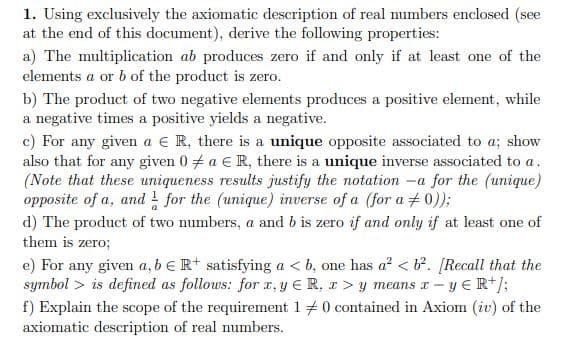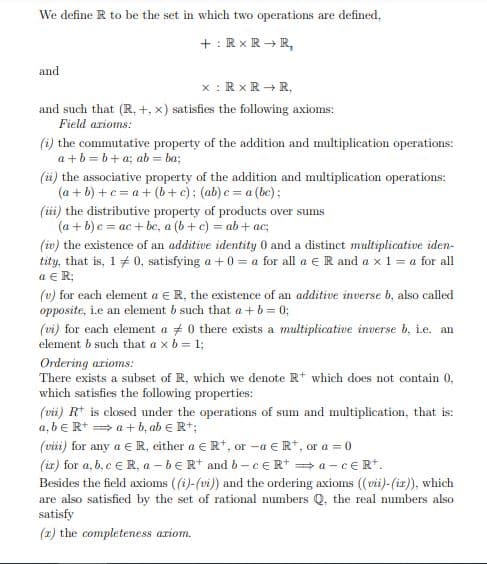1. Using exclusively the axiomatic description of real numbers enclosed (see at the end of this document), derive the following properties: a) The multiplication ab produces zero if and only if at least one of the elements a or b of the product is zero. b) The product of two negative elements produces a positive element, while a negative times a positive yields a negative. c) For any given a e R, there is a unique opposite associated to a; show also that for any given 0 # a € R, there is a unique inverse associated to a. (Note that these uniqueness results justify the notation opposite of a, and ! for the (unique) inverse of a (for a +0)); -a for the (unique) d) The product of two numbers, a and b is zero if and only if at least one of them is zero; e) For any given a, beRt satisfying a < b, one has a? < b?. [Recall that the symbol > is defined as follows: for I, y ER, r > y means r – y ER+); f) Explain the scope of the requirement 1 +0 contained in Axiom (iv) of the axiomatic description of real numbers.
1. Using exclusively the axiomatic description of real numbers enclosed (see at the end of this document), derive the following properties: a) The multiplication ab produces zero if and only if at least one of the elements a or b of the product is zero. b) The product of two negative elements produces a positive element, while a negative times a positive yields a negative. c) For any given a e R, there is a unique opposite associated to a; show also that for any given 0 # a € R, there is a unique inverse associated to a. (Note that these uniqueness results justify the notation opposite of a, and ! for the (unique) inverse of a (for a +0)); -a for the (unique) d) The product of two numbers, a and b is zero if and only if at least one of them is zero; e) For any given a, beRt satisfying a < b, one has a? < b?. [Recall that the symbol > is defined as follows: for I, y ER, r > y means r – y ER+); f) Explain the scope of the requirement 1 +0 contained in Axiom (iv) of the axiomatic description of real numbers.
Elements Of Modern Algebra
8th Edition
ISBN:9781285463230
Author:Gilbert, Linda, Jimmie
Publisher:Gilbert, Linda, Jimmie
Chapter3: Groups
Section3.1: Definition Of A Group
Problem 34E: 34. Let be the set of eight elements with identity element and noncommutative multiplication...
Related questions
Question
i need Q1 answer
other pic is just for reference (end of the document)

Transcribed Image Text:1. Using exclusively the axiomatic description of real numbers enclosed (see
at the end of this document), derive the following properties:
a) The multiplication ab produces zero if and only if at least one of the
elements a or b of the product is zero.
b) The product of two negative elements produces a positive element, while
a negative times a positive yields a negative.
c) For any given a e R, there is a unique opposite associated to a; show
also that for any given 0 a € R, there is a unique inverse associated to a.
(Note that these uniqueness results justify the notation
opposite of a, and ! for the (unique) inverse of a (for a + 0));
-a for the (unique)
d) The product of two numbers, a and b is zero if and only if at least one of
them is zero;
e) For any given a, bERt satisfying a < b, one has a' < b². [Recall that the
symbol > is defined as follows: for I, y ER, r > y means r – y ER+);
f) Explain the scope of the requirement 1 +0 contained in Axiom (iv) of the
axiomatic description of real numbers.

Transcribed Image Text:We define R to be the set in which two operations are defined,
+ : Rx R + R,
and
x : Rx R + R.
and such that (R, +, x) satisfies the following axioms:
Field arioms:
(i) the commutative property of the addition and multiplication operations:
a +b = b+ a; ab = ba;
(ü) the associative property of the addition and multiplication operations:
(a + b) +c = a+ (b+c); (ab) c = a (be);
(ii) the distributive property of products over sums
(a + 6) c = ac + be, a (b+ c) = ab+ ac;
(iv) the existence of an additive identity 0 and a distinct multiplicative iden-
tity, that is, 1 + 0, satisfying a +0 = a for all a E R and a x1 = a for all
a € R;
(v) for each element a € R, the existence of an additive inverse b, also called
opposite, i.e an element b such that a + b = 0;
(vi) for each element a + 0 there exists a multiplicative inverse b, ie. an
element b such that a x b = 1;
Ordering arioms:
There exists a subset of R, which we denote R* which does not contain 0,
which satisfies the following properties:
(vii) R* is closed under the operations of sum and multiplication, that is:
a, be R+ = a+ b, ab € Rt;
(viii) for any a ER, either a eR+, or -a e R*, or a = 0
(ir) for a, b, e e R, a -be Rt and 6-CER* = a -cERt.
Besides the field axioms ((i)-(vi) and the ordering axioms (vii)-(iz), which
are also satisfied by the set of rational mumbers Q, the real numbers also
satisfy
(x) the completeness ariom.
Expert Solution
This question has been solved!
Explore an expertly crafted, step-by-step solution for a thorough understanding of key concepts.
This is a popular solution!
Trending now
This is a popular solution!
Step by step
Solved in 4 steps with 3 images

Recommended textbooks for you

Elements Of Modern Algebra
Algebra
ISBN:
9781285463230
Author:
Gilbert, Linda, Jimmie
Publisher:
Cengage Learning,

Algebra & Trigonometry with Analytic Geometry
Algebra
ISBN:
9781133382119
Author:
Swokowski
Publisher:
Cengage

Linear Algebra: A Modern Introduction
Algebra
ISBN:
9781285463247
Author:
David Poole
Publisher:
Cengage Learning

Elements Of Modern Algebra
Algebra
ISBN:
9781285463230
Author:
Gilbert, Linda, Jimmie
Publisher:
Cengage Learning,

Algebra & Trigonometry with Analytic Geometry
Algebra
ISBN:
9781133382119
Author:
Swokowski
Publisher:
Cengage

Linear Algebra: A Modern Introduction
Algebra
ISBN:
9781285463247
Author:
David Poole
Publisher:
Cengage Learning